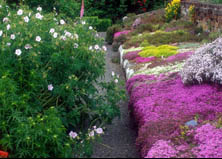New Gardening with Matthew Wilson
 Having spent a hardworking Saturday morning in the walled garden it was a bit of a treat to be able to sit and listen to Matthew Wilson giving a lecture in Corbridge to some 400 people. Organised by the combined Corbridge, Stocksfield and Wylam gardening clubs, his talk had the same name as his book, New Gardening: How to Garden in a Changing Climate. Based on his practical experience as curator of RHS gardens Hyde Hall and Harlow Carr, as well as his private garden at home, Matthew's philosophy of gardening has become honed into harmony with the specific environment of a garden and its unique microclimate whilst growing plants that will thrive in its particular conditions. There were many zeitgeist aspects of his talk, all put into action in his time of running these two major gardens: recycling materials, making composts, gardening for wildlife, careful water use, naturalistic planting schemes. He has wanted to write this book for some ten years. In these days of disposable culture, he believes that gardeners have a rather different approach; one of skill, patience, learning and and a different way of looking at the world. He believes that in a recession, there can be a renewed interest in gardening, words that echo something my friend, historic garden specialist, Nick Owen said only a couple of weeks ago when he gave a lecture on Capability Brown during a snowstorm...
Having spent a hardworking Saturday morning in the walled garden it was a bit of a treat to be able to sit and listen to Matthew Wilson giving a lecture in Corbridge to some 400 people. Organised by the combined Corbridge, Stocksfield and Wylam gardening clubs, his talk had the same name as his book, New Gardening: How to Garden in a Changing Climate. Based on his practical experience as curator of RHS gardens Hyde Hall and Harlow Carr, as well as his private garden at home, Matthew's philosophy of gardening has become honed into harmony with the specific environment of a garden and its unique microclimate whilst growing plants that will thrive in its particular conditions. There were many zeitgeist aspects of his talk, all put into action in his time of running these two major gardens: recycling materials, making composts, gardening for wildlife, careful water use, naturalistic planting schemes. He has wanted to write this book for some ten years. In these days of disposable culture, he believes that gardeners have a rather different approach; one of skill, patience, learning and and a different way of looking at the world. He believes that in a recession, there can be a renewed interest in gardening, words that echo something my friend, historic garden specialist, Nick Owen said only a couple of weeks ago when he gave a lecture on Capability Brown during a snowstorm...
Matthew is a natural raconteur and had the audience laughing at his reminiscences. At one point he made everyone in the hall stand up and say "I love aphids" - it felt like some corporate training session, not that I've ever been on one, having been self-employed as a gardener all my life! Point being that without the prey, the predator such as lacewing or ladybird wouldn't succeed. I could add blue tit because they seem to love delicately picking aphids off plants in my garden. He urged everyone to buy local, a point I couldn't agree with more! It often amazes me that we get visitors from all over Britain but local people seem to forget that they have a specialist nursery nearby and will go miles to a huge garden centre.
Received wisdom was challenged; why take up tulip bulbs when, given the right, dry conditions, they will come up every year and, in his book, there are examples of sensible spades that are not back-breaking. Why on earth are the majority of spades and forks still based on mining tools with short handles designed to used kneeling down! Looking through New Gardening, there are plenty of very practical ideas with clear illustrations making it a good reference book. I particularly liked the log pile bench and the adapted shed which uses logs end on and ferns planted vertically in the crevices. Something I haven't seen before are 'rammed earth walls' for raised vegetable beds.
Many of the techniques that Matthew writes about I use in Chesters Walled Garden; not watering or fertilising, for example, so that the borders are self-supporting. I do, however, largely 'put the garden to bed' so that I can have a bit of a winter break, much needed after the season, though I leave the grasses standing (great for overwintering insects) and the teasels for the goldfinches. And that season is just about to begin again as we open on March 21st so although I had a welcome rest this afternoon at his lecture, it's back to work preparing the garden.....




